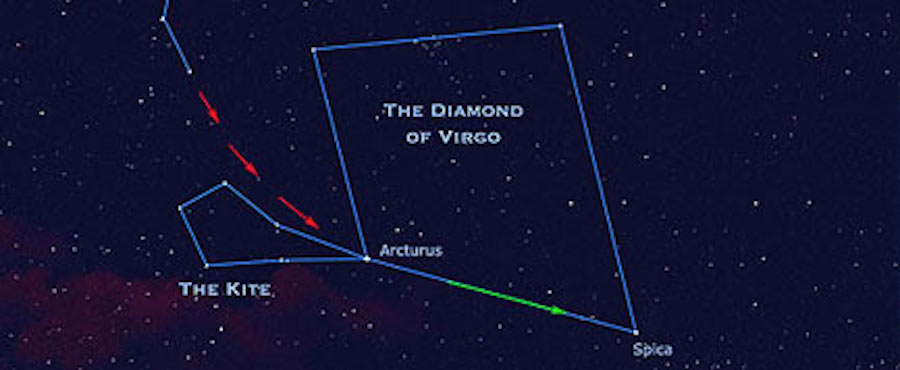
The brilliant star Arcturus sparkles with a golden yellow or topaz hue, high above the eastern horizon during the mid-evening hours. Arcturus, which lies in the constellation of Boötes, the Herdsman, ranks as the fourth-brightest star in the night sky, behind Sirius, Canopus and Alpha Centauri.
And back in the early 1930s, this star made the front page of every newspaper in the United States, when Arcturus was used to symbolically link two great world fairs that were separated by a span of 40 years. More on that in a moment.
As if it weren't easy enough to find, there is another way to spot Arcturus. Simply remember the following mnemonic phrase: "Follow the arc to Arcturus." In other words, look at the Big Dipper. Its handle is bent. Imagine extending a curve from the handle; continue that imaginary arc about the length of the Big Dipper, and you will ultimately come to Arcturus. [Best Night Sky Events of May 2014: Stargazing Sky Maps (Gallery)]
Some folks may add another line to the mnemonic: "Then speed to Spica," for that same arc, continued past Arcturus for roughly the same distance, will come to the bright bluish star Spica in the constellation of Virgo.
Arcturus has been estimated to be about 20 million miles (32 million kilometers) wide, making it roughly 25 times the diameter of the sun. It's about 115 times brighter than the sun.
In his definitive three-volume work "Burnham's Celestial Handbook," Robert Burnham, Jr. points out that the heat received from Arcturus can be measured using modern infrared-detecting instruments. It's found to "equal the heat of a single candle at a distance of about 5 miles."
Lighting up Chicago's World's Fair
Breaking space news, the latest updates on rocket launches, skywatching events and more!
It was 81 years ago this month — May 27, 1933, to be exact — that Arcturus became the object of a great publicity buildup in Chicago, at the opening of the Century of Progress Exposition.
Edwin Frost, the retired director of the Yerkes Observatory in Williams Bay, Wis., home to the world's largest refracting telescope, suggested a unique way to open the Fair. At 9:15 p.m. local time that night, telescopes focused the star's light on photoelectric cells, and the resulting current switched on the floodlights at the exposition grounds.
Arcturus was chosen for this task because Chicago had a great World's Fair in 1893 (the World's Columbian Exposition). The best estimates at the time said that it took light from Arcturus 40 years to reach Earth. So a story was built around the notion that the 1933 fair would be opened by light that had started its trip while the 1893 fair was still in progress. [Amazing Night Sky Photos for May (Gallery)]
However, more accurate measurements today place Arcturus 37 light-years away. So it was really starlight that started toward Earth in 1896 that turned on the lights of the 1933 fair — but what's 3 light-years among friends?
Here today, gone in 500,000 years
Another interesting fact about Arcturus is that it appears to shift its "fixed" position in the sky much more rapidly than most of the other bright stars (the sole exception being Alpha Centauri).
Sir Edmond Halley was the first to discover this motion back in 1718. Arcturus appears to zip through space at nearly 324,000 mph (521,000 km/h) in the direction of the constellation Virgo. It seems to move toward Virgo by about 1 degree (which is about twice the apparent width of a full moon) over a time span of about 1,500 years.
We are thus very fortunate to live at a time when the distance separating Arcturus and our solar system is nearly at its minimum. It will continue to approach Earth for several thousand more years, but then it will pass us as it continues to move toward Virgo and its distance will steadily increase.
Computations show that in approximately 500,000 years, Arcturus will probably be 800 light-years away from us and likely will have faded completely from naked-eye visibility.
Kite or cone?
Incidentally, the dots over the second "o" in Boötes mean that you should pronounce the vowels separately: Boo-OH-tes, not (as many people say), Boo-ties! It is a Greek word meaning a man who tends to a herd of cows, so why not refer to Bootes as the cowboy of the night sky?
In the allegorical pictures illustrating star atlases of a few hundred years ago, Boötes is usually pictured holding a large rod or staff. Boötes is supposedly chasing after Ursa Major, the Great Bear. This is why some legends refer to Boötes as "The Bear-guard."
On our sky map, Boötes resembles a narrow kite, but it might also be envisioned as an ice-cream cone, At the bottom of which shines Arcturus. Since the star has an orange hue, we might say that the cone is holding orange sherbet, and perhaps somebody bit off the bottom of the cone, allowing the last little glob to dribble out.
Joe Rao serves as an instructor and guest lecturer at New York's Hayden Planetarium. He writes about astronomy for Natural History magazine, the Farmer's Almanac and other publications, and he is also an on-camera meteorologist for News 12 Westchester, N.Y. Follow us @Spacedotcom, Facebook or Google+. Originally published on Space.com.

Joe Rao is Space.com's skywatching columnist, as well as a veteran meteorologist and eclipse chaser who also serves as an instructor and guest lecturer at New York's Hayden Planetarium. He writes about astronomy for Natural History magazine, Sky & Telescope and other publications. Joe is an 8-time Emmy-nominated meteorologist who served the Putnam Valley region of New York for over 21 years. You can find him on Twitter and YouTube tracking lunar and solar eclipses, meteor showers and more. To find out Joe's latest project, visit him on Twitter.

